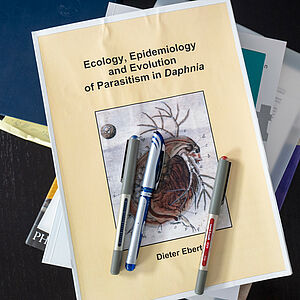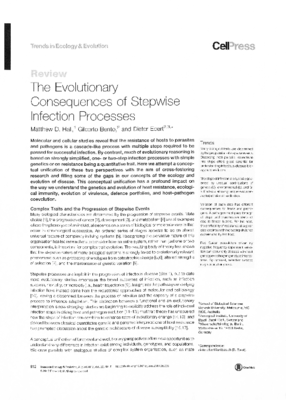
Dieter Ebert, Dr. phil.
Professor der Zoologie und Evolutionsbiologie
Universität Basel
Geboren 1961 in Saarburg, Deutschland
Studium der Biologie und Chemie an der Technischen Universität München, der University of South Alabama und der Universität Basel
Arbeitsvorhaben
The Time Scale of Antagonistic Coevolution
My research interest is in how host-parasite coevolution works. My current project addresses how research on different time scales can explain coevolutionary patterns and processes. In the Red Queen model of coevolution, parasites adapt to their hosts, and therefore the best-adapted forms increase in frequency. At the same time, the host types which are able to escape these parasites will increase in frequency. This selects for parasites that are able to exploit these new hosts and so on. Thus, a strategy that is successful now will not be of long value, as the antagonists evolve to get around it. However, strategies that were successful in the past may come back because the antagonist has changed in the meantime. This is called the Red Queen model, because the antagonist species need to run (evolve) constantly to maintain their position, just as the Red Queen does in Lewis Carroll’s fairy tale Alice in Wonderland. The Red Queen hypothesis of coevolution has been studied on time scales ranging from direct observations (from days to a few years), in sediment cores (several decades), post-glacial processes (about 10,000 years), all the way to the origin of the species involved (several million years). Studies on these different time scales differ strongly in their research methodology and assumptions. Here I want to write a conceptual review in which I scrutinize the evidence for coevolution with particular reference to the assumptions made when studying it across different time scales.I want to work out whether the evidences obtained from different time scales are congruent with each other. Can we use the same model to explain processes happening now with processes deep in the past? Alternatives have been suggested and will be compared with the Red Queen model. A further aim is to work out predictions of the Red Queen model that can be addressed equally on different time scales.
Recommended Reading
Ebert, Dieter (2008). “Host-Parasite Coevolution: Insights from the Daphnia-Parasite Model System.” Current Opinion in Microbiology 11 (3): 290–301. https://doi.org/10.1016/j.mib.2008.05.012.
Ebert, Dieter, and Peter D. Fields (2020). “Host-Parasite Coevolution and Its Genomic Signature.” Nature Reviews Genetics 21: 754–768. https://doi.org/10.1038/s41576-020-0269-1.
Köpfe und Ideen 2019
Wasserflöhe und die Geheimnisse der Evolution
ein Porträt von Dieter Ebert von Sonja Kastilan
Publikationen aus der Fellowbibliothek
Ebert, Dieter (London, 2020)
Host-parasite co-evolution and its geneomic signature
Ebert, Dieter (Amsterdam [u.a.], 2017)
The evolutionary consequences of stepwise infection processes
Ebert, Dieter (2013)
The epidemiology and evolution of symbionts with mixed-mode transmission
Ebert, Dieter (2013)
Ebert, Dieter (2011)
Ebert, Dieter (2010)
Intensive farming : evolutionary implications for parasites and pathogens
Ebert, Dieter (2010)
Ebert, Dieter (2009)
Comparative metagenomics of Daphnia symbionts
Ebert, Dieter (2008)
The evolution and expression of virulence
Ebert, Dieter (London, 2008)
Host-parasite coevolution : insights from the Daphnia-parasite model system
Im Kolleg entstanden 22.06.17
Veranstaltungen
Dieter Ebert
Dieter Ebert
Madeleine Beekman | Dieter Ebert | Jaeeun Kim | Robert Stam
Dieter Ebert


